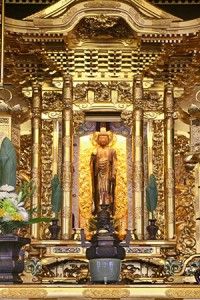
May 21, 2020
The Jodo Shinshu Service Book (17MB) is now available online. In this PDF version of Honpa Hongwanji’s 150-page “red service book,” you may click entries in the table of contents to go right to specific sections.
The content below is adapted from a laminated service guide provided in the pews at the Hawaii Betsuin temple. A printable version is available.
Terminology
Hongwanji means “Temple of the Primal Vow.” The Primal Vow is Amida Buddha’s promise to save all beings. The Shin or Jodo Shinshū path is one of many denominations of Mahayana Buddhism. Honpa is an abbreviation for Hongwanji-ha, the headquarters organization in Kyoto, Japan of worldwide Jodo Shinshu Buddhism.
The Shin Buddhist Altar
- Object of Reverence – Amida Buddha
May take 3 forms: Standing statue of wood, picture scroll, or scroll with the Kanji characters:
Na Mo A Mi Da Butsu
The figure of Amida Buddha, which occupies the central position in the altar, symbolizes the Buddha of Immeasurable Life (Compassion) and Infinite Light (Wisdom). The image symbolically represents ultimate reality and helps ordinary people grasp the vast complexity of our existence. Amida translates into “light and life” which helps our limited human ability to understand the unknowable. - Candles – The candle symbolizes the Wisdom of the Buddha that illuminates the darkness of ignorance.
- Flowers – The flowers symbolize the Compassion of the Buddha representing purity and beauty. In addition, because the flowers wilt they represent the impermanent nature of life.
- Incense – Incense is offered to thank Amida Buddha for his vow of salvation. The rich fragrance reminds us of the sweetness of this precious moment and prepares us to hear the Dharma.
- Rice – the staff of life. Represents interdependence and sharing.
- Greenery & Water – flowing water and sustainer of all life. Only flowing water remains pure and is the symbol of the Dharma, ever flowing, ever pure.
Shin Buddhist Rituals / Traditions
- Namo Amida Butsu (The Nembutsu) – reciting Buddha’s name, we think Buddha, Say Buddha, Are Buddha. In Jodo Shin Buddhism, the Nembutsu is not recited as a mantra or religious practice to gain merit, but recited in Awareness, Joy and Appreciation of Amida Buddha’s immense Compassion. Na mo A mida But su = Entrusting in the Buddha of Immeasurable Life (Compassion) and Infinite Light (Wisdom).
- Gassho – by placing our palms together and bowing before the image of the Buddha, we express our deepest gratitude to Compassion and Wisdom symbolized by the statue of the Buddha. The right hand symbolizes the Buddha, the left hand symbolizes yourself, together they symbolize Oneness with the Buddha.
- Nenju – The nenju symbolizes oneness and is used to be mindful of an awakened self. It is placed around the hands in gassho with the tassel hanging straight down. When not in use, it is placed on the left wrist or held with the left hand. In Shin Buddhism, nenju are “mindfulness” beads versus “counting” (juzu). Today, the Wrist Nenju, worn around one’s left wrist, is also very popular as a constant reminder of the Buddha, Dharma, Sangha.
- Oshoko – Incense is offered in gratitude for the teachings and to purify and prepare our minds for listening to the Dharma (Buddhist teachings).
- Vandana Ti-sarana (Triple Gem, Three treasures) – Ancient Indian chant affirming being a Buddhist. In English: “I venerate the Sacred One, the Great Sage, the Truly Enlightened One. I take refuge in The Buddha, I take refuge in The Dharma, I take refuge in The Sangha.”
- Chanting of Buddha’s Teachings – the Sound of Oneness, in which individual voices blend as one in a joyful expression of the embracing the Dharma together. In Shin Buddhism, both lay and clergy chant together.

A Typical Service
- Oshoko (Offering of Incense): We start our service with the offering of incense. This is an opportunity to connect with the Buddha and express gratitude for this precious gift of life. The fragrance purifies our minds and prepares one to listen to the Dharma. We bow in Gassho putting the hands together to signify the oneness of Buddha and all beings. It is customary to use a nenju (beads), around your hands at this offering.
- Ringing of the Bell (Kansho): A large bell is rung to signal the beginning of the service and allow time for focusing. Symbolizes the voice of Buddha calling out to “Come, seek refuge”.
- Reciting the Nembutsu (Namo Amida Butsu): This is the Japanese pronunciation of the original Sanskrit phrase (Namo’mitabhaya buddhaya) meaning “I take refuge in Amida Buddha.” It also means entrusting in the compassion and wisdom of true reality.
- Singing of Vandana Ti-sarana (Triple Treasures): Taking refuge in the Three Treasures (Buddha, Dharma, Sangha) is the universal affirmation of all Buddhists. The first part, which is sung, is in the ancient Pali language of India. The second part, which is recited in English, elaborates on the Pali verses.
- Singing of Gathas: In contrast to chanting, gathas (songs) are musical expressions of the sound of Oneness. Here’s an audio sample of the gatha Gratefulness II sung at Choralfest 2014. (See Choralfest 2014 on YouTube.)
- Sutra Chanting: The word sutra originally meant ‘thread’ so that literally, today, a sutra is the thread that ties the teachings of the Buddha into our lives. We chant the sutras aloud, in unison, in the traditional style. Since the chants are read in Sino-‐Japanese, they are not chanted for comprehension. Rather, it is a symbolic gesture of listening to the Dharma and is considered a form of mindfulness. The Jodo Shinshu tradition is unique, in that everyone, not only the priests, are encouraged to chant together. Through participation in the chanting, the full experience of the Buddhist service is realized.
- Dharma Talk: Usually by a minister to share a message about the Buddhist teachings.
- Singing the Nembutsu: Everyone joining together in joyous harmony by singing Namo Amida Butsu.
A how-to video on offering incense from Gardena Buddhist Church (CA). (Don’t worry, perfection is not expected!)
After service, an informal gathering is held. It is an opportunity for people to gather, to ask questions, share their insights, and share each other’s company over light refreshments.
References:
Traditions of Jodoshinshu Hongwanji‐ha by Masao Kodani and Russell Hamada, Pureland Publications, 1995
Jodo Shinshu – A Guide by the Hongwanji International Center, published by Buddhist Churches of America, 2004

